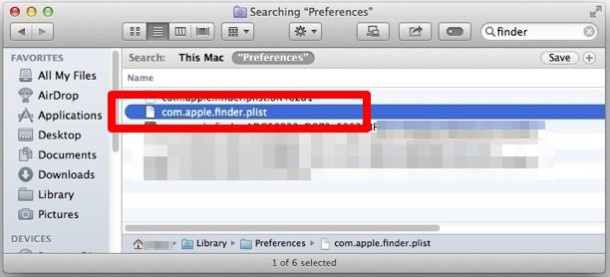Finder is the file manager in OS X, and it’s actually one of the oldest components of the Mac operating system, having been around since the earliest days of Mac OS. Despite it’s long history, many users who have upgraded to OS X Mavericks have discovered some peculiar behavior with Finder, where it can become extremely sluggish and slow doing when in use, even when doing just about anything. With some minor investigation through Activity Monitor, it’s typical to discover that the Finder process is pegging CPU, sitting somewhere between 80% to 200% – again, Finder is seemingly doing nothing strenuous or out of the ordinary.

Having encountered this problem on several Macs that have been upgraded to 10.9 from 10.7 and 10.8 (it has yet to occur on a clean install of Mavericks for what it’s worth), a fairly reliable solution has been found to resolve the high CPU usage and speed issues with Mavericks Finder: trashing the plist file and forcing it to rebuild.
* If you’re comfortable using the command line and Terminal, jump down to find a faster solution.
- From the OS X Finder, hit Command+Shift+G to summon “Go To Folder” and enter the following path:
~/Library/Preferences/
- Locate the file named “com.apple.finder.plist” and move it to the desktop (this should make a copy of the file, if not, hold down the Option key when moving it to make a copy) – this serves as a backup in the unlikely event something goes wrong
- Delete the remaining com.apple.finder.plist file from the ~/Library/Preferences/ folder

- Launch Terminal, found in /Applications/Utilities/ and enter the following command:
killall Finder
- Hit return to execute the command and force the Finder to relaunch, Finder should now behave
Trashing the com.apple.finder.plist file basically resets Finder to the default settings. This means you will need to reconfigure custom Finder preferences if you made any through Finder > Preferences. This includes things like the default new window, tab preferences, what is shown on the desktop, sidebar items, changes to search preferences, filename extensions, etc.
* Comfortable with Terminal? Advanced users who are familiar with the command line can use the following command sequence to put the entire sequence into a single command string:
rm ~/Library/Preferences/com.apple.finder.plist&&killall Finder
This will delete the preference file and relaunch Finder. If you’re not comfortable with the command line this is best avoided because an error with the ‘rm’ command could theoretically remove unintended files without warning.
Whichever method you use to trash the file from the user Library folder, the result of ditching the Finder preference file is a dramatically calmed down Finder process. If you’ve been following Activity Monitor throughout the troubleshooting process you should now find the Finder process hovering somewhere below 8% if not barely on the radar at 1% now under the same conditions.

This is obviously a huge improvement, so whether the original cause is simple preference corruption that occurred during the process of upgrading to Mavericks, or something else entirely, thankfully there’s a very easy resolution.
Assuming all is well, you can trash the backup “com.apple.finder.plist” file made during step 2.
Thanks to the guys at OSXDaily.com


